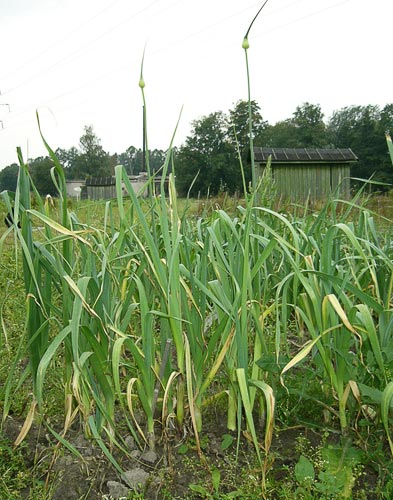Crops
Allium sativum L. - Garlic.
Taxonomic position.
Family Alliaceae J.Agardh, genus Allium L.Biology and morphology.
2n=16. Perennial grassy plant up to 100 cm hight. Cultivated as annual plant. Fibrous rot system. Leaves length 30-40 (up to 100) cm, unhollow, with wide leaves blade, lanceolate-stretched, acerate to the top, groove, with keel on lower side, blueish-green, light-green or dark-green colour, sometimes with anthocian. Winter forms have false stem (height 35-80 cm), which consist from leaves axils put each in other. Bulb compound, spherical, a little flattened, ovaty-costate shape, weight 20-50 (130) g, diameter 3-6 (8) cm, covered by dry glumes. Bulb consists from number of daughter bulbs (10-12), covered by dry glumes too. Daughter bulb is a flashy basal part of one leaf. Weight of daughter bulb 1-2-5 g and more. Bulbs can be white, yellowish, dark-violet or pinkish-violet colour. Peduncule length up to 1.5 m, before flowering it is twisted into spiral and ended by umbelliform inflorescence , which is covered by chaffed case with rostrum. Fine aerial bulbils (1.5-3 mm length) are formed in an inflorescence except for flowers. Fruits and seeds are not formed. Propagates by daughter bulbs and by aerial bulbils. All plant fas specific garlicky smell. Differ winter and spring-sown forms.Winter grades: Alkor, Bashkirskij 85, Dubkovskij, Dunganskij mestnyj, Novosibirskij, SIR 10, Shirokolistnyj 220, Yubileinyj gribovskij, Dobrynja, Nadezhnyj.
Spring-sown grades: Abrek, Alejskij, Viktorio, Gulliver, Elenovskij, Sochinskij 56.
Distribution.
The native land - Middle Asia, where it meets in as a wild plant. In Russia cultivated from 17 century. On territory of the former USSR planting everywhere and occupies about 6 thousand hectares. General plantations situated in Middle Asia, Caucasus, Ukraine, southern (winter grades) and middle (spring-sown grades) regions of European part of Russia.Ecology.
Coldresistant, tolerates frost up to minus 40-45°C under snow and minus 8-10°C without snow. Optimum temperature of growth 18-25°C. Photophilous. Plant of long day. It is requiring to humidity and fertility of soil. Prefer fertile, light-loamy and sandy soils with deep level of ground water. Not tolerant to acid and salinizated soil. The vegetative period 90-120 days, depending on grade, type of cultivation and climat zone.Economic value.
High feed and medicinal properties. The bulb contains 15-28 % sugars, 6-13.3 % proteins, mineral salts, vitamins C, B1, B2, PP, carotin, essential oils. It is used in food as fresh, cooked, baked, fried, salty, pickled, dried. It is used as seasoning. Leaves used as potherb in southern regions. Has bactericidal properties, use by hipertonia, atonia of intestines. Phytoncidal properties used against pests and plant diseases. Average productivity of winter garlic 6-8 (up to 18-20) ton per hectare, spring-sown grades 5-7 (up to 10-12) ton per hectare.The literature.
Alekseeva M.V. Cultural onions. Moscow, 1960.Alekseeva M.V. Garlic. Moscow, 1979.
Bekseev Sh. Vegetable cultures of the world. The encyclopedia of truck farming. St.Petersburg, 1998.
Ershov I.I. Onion; Garlic. Moscow, 1978.
Ganichkina O.A. Onion and garlic. Moscow, 2000.
Kazakova A.A. Onion //Cultural flora of the USSR. Ed. by D.D.Brezhnev. Leningrad, 1978.
Lihatskij V.I. Garlic. Kiev, 1990.
Onion; garlic. Comp. T.E.Lushchits. Minsk, 2001.
Sowing areas in all categories of farms by sojuz republics in 1987. Moscow, 1988.
Vehov V.N., Gubanov I.A., Lebedeva G.F. Cultural plants of the USSR. Moscow, 1978.


